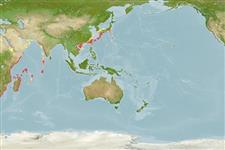>
Pleuronectiformes (Flatfishes) >
Soleidae (Soles)
Etymology: Aseraggodes: Greek, aggos, -eos, -ous = vessel, uterus, carapace of a crab + Greek, aseros, -a, -on = to remove the appetite (Ref. 45335).
Environment: milieu / climate zone / depth range / distribution range
экология
морской демерсальный; пределы глубины 6 - 10 m (Ref. 56490). Temperate
Indo-West Pacific: Sodwana Bay (South Africa), Porto Amelia (Mozambique) and Japan.
Size / Вес / Возраст
Maturity: Lm ? range ? - ? cm
Max length : 8.0 cm TL самец/пол неопределен; (Ref. 3200)
колючие лучи спинного плавника (общее число): 0; членистые (мягкие) лучи спинного плавника (общее число): 64-67; колючие лучи анального плавника 0; членистые (мягкие) лучи анального плавника: 42 - 44; позвонки: 33 - 34. Diagnosis: Dorsal rays 64-67; anal rays 42-44; dorsal and anal rays are not branched. Caudal rays 18, the middle 14 branched. Lateral-line scales of ocular side 64-67; the line extending forward nearly to upper eye, with a ventral branch on head following the edge of the preopercle. Vertebrae 10 + 23-24. Dorsal pterygiophores anterior to fourth neural spine 14-15. Body depth 2.4-2.5 in SL; head length 3.55-3.65 in SL; snout long, 2.6-2.95 in head length; interorbital space narrow, 13.7-20.8 in head length. Caudal peduncle very short, 19.5-23.2 in HL. Tubular anterior nostril anterior to upper edge of lower eye, just reaching cutaneous edge of lower orbit when depressed posteriorly. Two rows of scales in interorbital space, none extending onto medial edges of eyes. Anterior edge of snout of largest specimen (23 mm SL) with a series of 12 conspicuous lappet-like cirri. Ventral margin of head with 20 similar cirri, the longest on chin about equal to pupil diameter; no cirri on opercular edge of either side of gill opening. Jaws of blind side surrounded by a zone of small papillae. Dorsal and anal rays long, the longest dorsal ray 2.5-3.0 in HL. No sheath of scales over base of dorsal and anal fins, at most one row of scales over basal part of rays. Rounded caudal fin and moderately long, 3.2-3.45 in SL. Pelvic fins long, reaching base of third or fourth anal ray, 1.65-1.9 in HL. Color of ocular side when fresh light gray with large irregular dark-edged white spots on head and body, scattered small whitish spots, fewer small black spots, a black spot the size of eye on lateral line in middle of body and a double black spot on lateral line in middle of posterior half of body (Ref. 56490).
Inhabits sand bottoms including reef flats and tide pools in 0-10 m (Ref. 90102).
Life cycle and mating behavior
половая зрелость | размножение | нерест | икра | Fecundity | личинки
Heemstra, P.C. and O. Gon, 1986. Soleidae. p. 868-874. In M.M. Smith and P.C. Heemstra (eds.) Smiths' sea fishes. Springer-Verlag, Berlin. (Ref. 3200)
Статус Красного Списка МСОП (Ref. 130435)
Угроза для людей
Harmless
Использование человеком
дополнительная информация
народные названиясинонимыобмен веществхищникиэкотоксикологияразмножениеполовая зрелостьнерестSpawning aggregationFecundityикраРазвитие икры
ссылкиаквакультура (рыбоводство)особенности рыбоводствастепень растяжениягенетикаElectrophoresesнаследуемостьболезниобработкаNutrientsMass conversion
инструменты
Специальные отчеты
Скачать в формате XML
ресурсы в Интернет
Estimates based on models
Preferred temperature (Ref.
123201): 23.5 - 28.9, mean 27 °C (based on 509 cells).
Phylogenetic diversity index (Ref.
82804): PD
50 = 0.5000 [Uniqueness, from 0.5 = low to 2.0 = high].
Bayesian length-weight: a=0.00977 (0.00473 - 0.02021), b=3.07 (2.90 - 3.24), in cm total length, based on LWR estimates for this (Sub)family-body shape (Ref.
93245).
Trophic level (Ref.
69278): 3.4 ±0.5 se; based on size and trophs of closest relatives
устойчивость к внешним воздействиям (Ref.
120179): высокий, минимальное время удвоения популяции до 15 месяцев (Preliminary K or Fecundity.).
Fishing Vulnerability (Ref.
59153): Low vulnerability (10 of 100).
